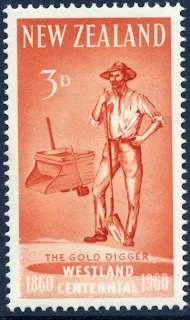Following the example of many other provinces of New Zealand this commemorative set of three stamps was issued to mark the Centenary of Westland. The stamps recognised the first explorers, miners and women of the region.
The first Europeans to visit the West Coast were Brunner and Heaphy, whose exploration began in 1846. Until 1856 the only European visitors to the Coast seem to have been sealers from Foveaux Strait and shore whalers operating from the Jackson Bay area.
In the late 1850s the first detailed survey of the West Coat was undertaken for the Nelson Provincial Government by John Rochfort, who is said to have named the area Westland. The year 1860 saw the transfer of Westland to the British. The Assistant Native Secretary, James Mackay, began negotiations with the chief of the coastal Maori. As a result, all tribes gathered at Poherua Lagoon near Okarito, there Mackay offered the Maori 300 gold sovereigns, on behalf of the Governor, in exchange for their territory - with the condition that certain lands should be set aside as native reserves. The offer was accepted and on 21 May 1860 the agreement was signed.
Westland became an independent territory in 1868, by virtue of the County of Westland Act, being separated from the Canterbury Province. Westland County was raised to the status of a Province on 1 December 1873.

1960 3d Gold Digger, Westland Centennial issue, major area of orange
partially omitted from Press cleaning fluid on plate.
Some of the images in this post were used with permission from the illustrated catalogue of StampsNZ
In the late 1850s the first detailed survey of the West Coat was undertaken for the Nelson Provincial Government by John Rochfort, who is said to have named the area Westland. The year 1860 saw the transfer of Westland to the British. The Assistant Native Secretary, James Mackay, began negotiations with the chief of the coastal Maori. As a result, all tribes gathered at Poherua Lagoon near Okarito, there Mackay offered the Maori 300 gold sovereigns, on behalf of the Governor, in exchange for their territory - with the condition that certain lands should be set aside as native reserves. The offer was accepted and on 21 May 1860 the agreement was signed.
Westland became an independent territory in 1868, by virtue of the County of Westland Act, being separated from the Canterbury Province. Westland County was raised to the status of a Province on 1 December 1873.
2d - Early Explorer. 3d - The Gold Digger.
Westland is a area of land between the rugged Southern Alps and the wild Tasman Sea. The westerly winds rise over the mountains they drop their water as rain giving this area some of the highest rainfall in New Zealand.
To explore and live here people had to be tough. One reason why the area was explored and opened up so late was its rugged terrain and lush thick forests almost impossible to penetrate. For those who did explore Westland, the rewards were the discovery of gold and other minerals; good productive farmland once the bush was cleared.
8d - Pioneer Woman.
The official First Day Cover - 16 May 1960.
The cover features three modes of transport used to get to Westland. Via horse drawn stage-coach over the Alps, via aircraft above the Alps and finally via train under the Alps. Notice this cover shows the Greymouth post cancel. Greymouth is the largest town in Westland situated at the mouth of the Grey River.
The cover features three modes of transport used to get to Westland. Via horse drawn stage-coach over the Alps, via aircraft above the Alps and finally via train under the Alps. Notice this cover shows the Greymouth post cancel. Greymouth is the largest town in Westland situated at the mouth of the Grey River.

1960 3d Gold Digger, Westland Centennial issue, major area of orange
partially omitted from Press cleaning fluid on plate.
Technical information:
Date of Issue:
|
16 May 1960
|
|---|---|
Designers:
|
G R Smith and G Bull, Wellington
|
Printers:
|
Harrison and Sons, England
|
Stamp Size:
|
25mm x 41mm
|
Sheet Size:
|
120 stamps per sheet
|
Process:
|
Photogravure
|
Perforation Gauge:
|
14 x 14.5
|
Paper Type:
|
Guard Bridge, multiple NZ and star watermark
|
Some of the images in this post were used with permission from the illustrated catalogue of StampsNZ
You can visit their web site and On-line Catalogue at, http://stampsnz.com/





We appreciate your engagement with our content. To ensure a respectful and constructive community, please take note of the following:
- No Spam, Please: We do not tolerate spammy or promotional comments. Any such comments will be promptly removed.
- Moderation in Place: All comments are moderated to maintain a positive and inclusive environment. Please be patient, as it may take a little time for your comment to appear.
- Sign In with Google: To comment, please sign in using your Google account. This helps us maintain the integrity of our community and allows for better interaction.